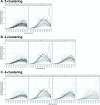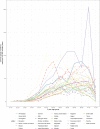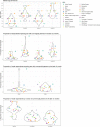Approximating missing epidemiological data for cervical cancer through Footprinting: A case study in India
- PMID: 37227260
- PMCID: PMC10212556
- DOI: 10.7554/eLife.81752
Approximating missing epidemiological data for cervical cancer through Footprinting: A case study in India
Abstract
Local cervical cancer epidemiological data essential to project the context-specific impact of cervical cancer preventive measures are often missing. We developed a framework, hereafter named Footprinting, to approximate missing data on sexual behaviour, human papillomavirus (HPV) prevalence, or cervical cancer incidence, and applied it to an Indian case study. With our framework, we (1) identified clusters of Indian states with similar cervical cancer incidence patterns, (2) classified states without incidence data to the identified clusters based on similarity in sexual behaviour, (3) approximated missing cervical cancer incidence and HPV prevalence data based on available data within each cluster. Two main patterns of cervical cancer incidence, characterized by high and low incidence, were identified. Based on the patterns in the sexual behaviour data, all Indian states with missing data on cervical cancer incidence were classified to the low-incidence cluster. Finally, missing data on cervical cancer incidence and HPV prevalence were approximated based on the mean of the available data within each cluster. With the Footprinting framework, we approximated missing cervical cancer epidemiological data and made context-specific impact projections for cervical cancer preventive measures, to assist public health decisions on cervical cancer prevention in India and other countries.
Keywords: HPV prevalence; cervical cancer incidence; classification; clustering; epidemiology; global health; impact projection; sexual behaviour; viruses.
© 2023, Man et al.
Conflict of interest statement
IM, DG, MB, IB No competing interests declared
Figures






Update of
- doi: 10.1101/2022.06.28.22276994
Similar articles
-
Evidence-based impact projections of single-dose human papillomavirus vaccination in India: a modelling study.Lancet Oncol. 2022 Nov;23(11):1419-1429. doi: 10.1016/S1470-2045(22)00543-5. Epub 2022 Sep 26. Lancet Oncol. 2022. PMID: 36174583 Free PMC article.
-
Prevalence and determinants of high-risk human papillomavirus infection in middle-aged Indian women.Sex Transm Dis. 2011 Oct;38(10):902-6. doi: 10.1097/OLQ.0b013e318223be5f. Sex Transm Dis. 2011. PMID: 21934560
-
Global burden of human papillomavirus and related diseases.Vaccine. 2012 Nov 20;30 Suppl 5:F12-23. doi: 10.1016/j.vaccine.2012.07.055. Vaccine. 2012. PMID: 23199955 Review.
-
Social differences in sexual behaviour and cervical cancer.IARC Sci Publ. 1997;(138):309-17. IARC Sci Publ. 1997. PMID: 9353671 Review.
-
Analysis of time trends of prevalence of high-risk HPV infections, high grade cervical precancer and cervical cancer disease in women from Eastern India over 20 years - Pooled analysis from three studies.Cancer Epidemiol. 2025 Apr;95:102776. doi: 10.1016/j.canep.2025.102776. Epub 2025 Feb 18. Cancer Epidemiol. 2025. PMID: 39970849
Cited by
-
Building resilient cervical cancer prevention through gender-neutral HPV vaccination.Elife. 2023 Jul 24;12:e85735. doi: 10.7554/eLife.85735. Elife. 2023. PMID: 37486822 Free PMC article.
-
Identifying Data-Driven Clinical Subgroups for Cervical Cancer Prevention With Machine Learning: Population-Based, External, and Diagnostic Validation Study.JMIR Public Health Surveill. 2025 Mar 19;11:e67840. doi: 10.2196/67840. JMIR Public Health Surveill. 2025. PMID: 40106366 Free PMC article.
-
Health and economic effects of introducing single-dose or two-dose human papillomavirus vaccination in India.BMJ Glob Health. 2023 Nov;8(11):e012580. doi: 10.1136/bmjgh-2023-012580. BMJ Glob Health. 2023. PMID: 37931940 Free PMC article.
References
-
- Bonjour M, Charvat H, Franco EL, Piñeros M, Clifford GM, Bray F, Baussano I. Global estimates of expected and preventable cervical cancers among girls born between 2005 and 2014: a birth cohort analysis. The Lancet. Public Health. 2021;6:e510–e521. doi: 10.1016/S2468-2667(21)00046-3. - DOI - PMC - PubMed
-
- Bouvard V, Wentzensen N, Mackie A, Berkhof J, Brotherton J, Giorgi-Rossi P, Kupets R, Smith R, Arrossi S, Bendahhou K, Canfell K, Chirenje ZM, Chung MH, Del Pino M, de Sanjosé S, Elfström M, Franco EL, Hamashima C, Hamers FF, Herrington CS, Murillo R, Sangrajrang S, Sankaranarayanan R, Saraiya M, Schiffman M, Zhao F, Arbyn M, Prendiville W, Indave Ruiz BI, Mosquera-Metcalfe I, Lauby-Secretan B. The IARC perspective on cervical cancer screening. The New England Journal of Medicine. 2021;385:1908–1918. doi: 10.1056/NEJMsr2030640. - DOI - PubMed
-
- Bray F, Mery L, Piñeros M. Cancer incidence in five continents. Ci5. 2017 http://ci5.iarc.fr
-
- Breiman L. Random forests. Machine Learning. 2001;45:5–32. doi: 10.1023/A:1010933404324. - DOI

